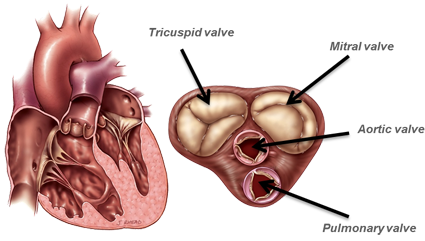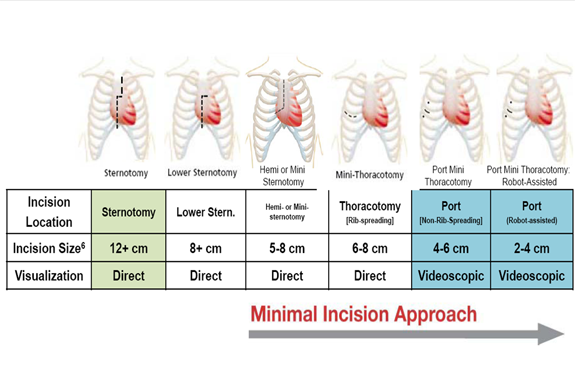Minimally Invasive Valve Surgery
Some patients may qualify for surgery that does not require a large incision or cutting through the entire breastbone. Your surgeon gains access to your heart through up to three smaller, less visible incisions, sometimes called “ports.” The cuts are made between your ribs or a smaller breastbone incision, as well as one small incision in the groin. The diseased valve is then repaired through the ports, with your surgeon watching your heart through a small tube-shaped camera.

Benefits
With the obvious benefit of less trauma to the chest and sternum, recovery times are generally faster with minimally invasive techniques (1 to 4 weeks versus 6 to 8 weeks), and rehabilitation is improved as patients can use their arms faster. The incisions leave only tiny scars, so the procedure greatly improves cosmetic results.
Other possible benefits may include a shorter hospital stay (2 to 5 days as opposed to 7 to 10), lower risk of infection, and lower risk of bleeding or a blood transfusion.

Types of Minimally Invasive Valve Surgeries
Surgical Valve Repair
When possible, it is often preferable to surgically repair the patient’s valve rather than to replace it with a prosthetic device. Valve repair usually involves the surgeon modifying the tissue or underlying structures of the mitral or tricuspid valve and implanting an annuloplasty ring or band. Aortic valves are rarely repaired.
Surgical Valve Replacement
If the diseased native heart valve cannot be repaired, the surgeon may choose to replace it. The first step is to remove the diseased valve and then implant a prosthetic valve in its place. Prosthetic valves come in different sizes to fit the patient and are made from a variety of materials.
- Tissue (bioprosthetic) valves - made primarily from animal heart tissue from pigs or cows, or valves donated from humans
- Mechanical valves – created from synthetic (man-made) materials
Who Can Get Minimally Invasive Surgery?
Not everyone is a candidate for these techniques, and your surgeon will review the results of your diagnostic tests to determine the best path for you. Your surgical team will carefully compare the advantages and disadvantages of minimally invasive techniques versus traditional surgery methods. The recommended treatment depends on the type and severity of your heart disease, age, medical history, lifestyle, and other factors.
Recovery
You may feel some discomfort at the incision site after surgery, and if you’d like, your doctor can provide you with medication for relief. Patients who have minimally invasive surgery may be able to go home 2 to 5 days after surgery.
Your healthcare team will follow your progress and help you recover as quickly as possible. You’ll receive specific instructions for your recovery and return to work, including guidelines for activity, driving, incision care and diet. To maintain your cardiovascular health after surgery, you will need to make lifestyle changes and take your medications as prescribed. Heart-healthy lifestyle changes that are important to your recovery include:
- Quitting smoking
- Treating high cholesterol
- Managing high blood pressure and diabetes
- Exercising regularly
- Maintaining a healthy weight
- Eating a heart-healthy diet
- Participating in a cardiac rehabilitation program, as recommended
- Following up with your doctor for regular visits
To talk to someone at the VCU Heart Valve Center and learn more about these procedures, call (804) 628-4327.

